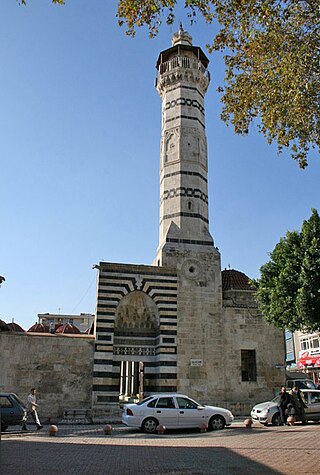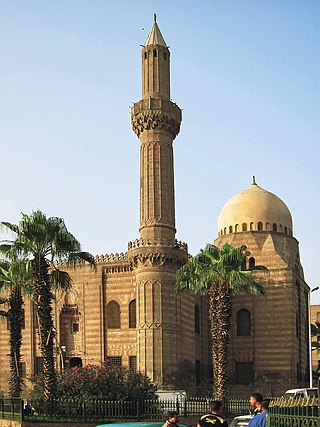
The Prophet's Mosque is the second mosque built by the Islamic prophet Muhammad in Medina, after that of Quba, as well as the second largest mosque and holiest site in Islam, after the Masjid al-Haram in Mecca, in the Saudi region of the Hejaz. The mosque is located at the heart of Medina, and is a major site of pilgrimage that falls under the purview of the Custodian of the Two Holy Mosques.

The Süleymaniye Mosque is an Ottoman imperial mosque located on the Third Hill of Istanbul, Turkey. The mosque was commissioned by Suleiman the Magnificent and designed by the imperial architect Mimar Sinan. An inscription specifies the foundation date as 1550 and the inauguration date as 1557, although work on the complex probably continued for a few years after this.

The Mosque-Madrasa of Sultan Hasan is a monumental mosque and madrasa located in Salah al-Din Square in the historic district of Cairo, Egypt. It was built between 1356 and 1363 during the Bahri Mamluk period, commissioned by Sultan an-Nasir Hasan. The mosque was considered remarkable for its massive size and innovative architectural components, and is still considered one of the most impressive historic monuments in Cairo today.

The Eyüp Sultan Mosque is in the Eyüp district of Istanbul, outside the city walls and near the Golden Horn. The mosque complex includes a mausoleum marking the spot where Ebu Eyüp el-Ansari, the standard-bearer and companion of the Islamic prophet Muhammad, is said to have been buried. On a much older site, the present building dates from the beginning of the 19th century.

Djamaa el Kebir, also known as the Great Mosque of Algiers, is a historic mosque in Algiers, Algeria. It is located within the Casbah, near the city's harbor. Dating to 1097, it is one of the few remaining examples of Almoravid architecture, although it has undergone other additions and reconstructions since its foundation. It is the oldest mosque in Algiers and is said to be one of the oldest mosques in Algeria after Sidi Okba Mosque and Sidi Ghanem Mosque.

Al-Tawbat mosque is a mosque in Tripoli, Lebanon. It was a Mamluk construction built in the 14th century. No founding inscription exists, maybe an existing one was destroyed by a flood. So the exact time of construction is not known. Perhaps it was built during the third reign of Al-Nasir Muhammad. The building was destroyed by a flood that occurred on January 20, 1612. The mosque was restored in June of the same year. An inscription tells about the construction and restoration by Husayn Pasha ibn Yusuf Sayfa, the governor of Tripoli.

The Sinan Pasha Mosque is an early Ottoman-era mosque in Damascus, Syria, located along Suq Sinaniyya Street.

The Great Mosque of Adana, also known as the Ramazanoglu Mosque Turkish: Ramazanoğlu Camii), is a 16th-century mosque in Adana, Turkey. It forms part of a complex (külliye) that includes a madrasah and a mausoleum (türbe). The buildings are on Kızılay street, next to the Ramazanoğlu Hall.

Bab Al-Asbat Minaret, Minaret of the Tribes, is a minaret in Jerusalem. The other name is the Minaret of Salahiyah which refers to the Salahiyah School close to it. It is one of the four minarets of Al-Aqsa, and is situated along the north wall.

The Al-Aqsa mosque compound in the Old City of Jerusalem has four minarets in total: three on the western flank and one on the northern flank.

Emirgan Mosque, officially Emirgan Hamid-i Evvel Mosque is an 18th-century Ottoman mosque located in the Emirgan neighborhood of the Sarıyer district in Istanbul, Turkey.

Sulayman Pasha al-Khadem Mosque, also known as Sariat al-Jabal Mosque, is a historical mosque established in 1528 by Suleiman Pasha Al-Khadem, one of the Ottoman rulers of Egypt. It is located inside the Cairo Citadel at the top of Mount Mokattam, and originally erected for the use of the janissaries stationed in the northern enclosure. It is the first mosque established in Egypt in Ottoman architectural style.

The Haydar-Khana Mosque is a historic mosque located near al-Mutanabbi Street in Baghdad, Iraq, built by al-Nasir during the Abbasid Caliphate. The mosque is situated on al-Rasheed Street and is located in the Haydar-Khana locality surrounded by buildings, shrines, and cafés. The mosque is an important historic landmark that reflect the society of Baghdad, intellectual gatherings, and fueling enthusiasm for demonstrations.

The Mosque-Madrasa of al-Ahmadiyya, also commonly known as al-Ahmadiyya Mosque or al-Maidan Mosque, is a historic Sunni Islam mosque located in Baghdad, Iraq. The mosque is located at al-Rasheed Street in the southern part of al-Rusafa, and the east of al-Maidan Square near al-Muradiyya Mosque.

Mahmud al-Kurdi Mosque or Jamal al-Din Mahmud al-Istadar Mosque is a historic mosque in Cairo, Egypt. It was founded by an amir called Mahmud al-Kurdi who was the ustadar or majordomo of the Mamluk Sultan Barquq. It is located just south of the Qasaba of Radwan Bey which branches out from the Ahmad Maher Street, in Historic Cairo, in the district of al-Darb al-Ahmar.

Al-Mahmoudia Mosque or the Mosque of Mahmud Pasha is a historic mosque in the city of Cairo, Egypt. It is located at the Salah al-Din Square in the Citadel of Cairo area, in front of Bab al-Azab gate of the citadel. There are Sultan Hassan Mosque and Al-Rifa'i Mosque to the east.

The Eger minaret is an Ottoman-era minaret tower located in Eger city, northern Hungary. It is one of the most northern minarets left from Ottoman rule in Europe. The minaret is 40 metres high and built from red sandstone. It was built in the early 17th century as part of the Djami of Kethuda mosque and used for the Muslim call to prayer (Adhan). The mosque no longer exists, but the minaret survives as a preserved monument of Hungary and a major tourist attraction of Eger. There are 98 steps on the spiral staircase inside, which leads to a balcony at 26 meters from the ground, offering unique views of the surrounding city.

Laleli Mosque is a mosque in the Abdi Çavuş quarter of the walled city of Nicosia, currently located in North Nicosia. It is located on Ali Ruhi Street. Its name, meaning "the Mosque with Tulips", is thought to be derived from the tulip motifs adorning its original minaret. Originally a small medieval chapel, it was enlarged and converted to a mosque in the 19th century.

The Abd al-Wahid Mosque is a mosque and one of the remains of Mamluk architecture in Tripoli, Lebanon. It was built in AH 705 (1305/1306) by Abd al-Wahid al-Miknasi according to the founding inscription. Stories tell that the Muslim Abd al-Wahid al-Miknasi from Meknes was visiting Tripoli after its Muslim conquest from the crusaders. He stayed at the khan of a Christian who didn't treat him well. The wealthy Abd al-Wahid offered to buy the khan and after its acquisition transformed it into a mosque. The stories of a transformation of a khan into a mosque can be supported by material evidence: That the mihrab is located at an angle to the qibla suggests that an older wall was reused.

Sheikh Ma'ruf Cemetery, also known as Maqbarat Shuniziyyah, is a historic cemetery located in the neighborhood of Karkh in Baghdad, Iraq. The cemetery's name is derived from Ma'ruf Karkhi, a Sufi mystic who is buried in here. Several historic mausoleums are present in the cemetery, such as the Zumurrud Khatun Mosque and Mausoleum.






















